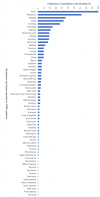Tick borne relapsing fever - a systematic review and analysis of the literature
- PMID: 35171908
- PMCID: PMC8887751
- DOI: 10.1371/journal.pntd.0010212
Tick borne relapsing fever - a systematic review and analysis of the literature
Abstract
Tick borne relapsing fever (TBRF) is a zoonosis caused by various Borrelia species transmitted to humans by both soft-bodied and (more recently recognized) hard-bodied ticks. In recent years, molecular diagnostic techniques have allowed to extend our knowledge on the global epidemiological picture of this neglected disease. Nevertheless, due to the patchy occurrence of the disease and the lack of large clinical studies, the knowledge on several clinical aspects of the disease remains limited. In order to shed light on some of these aspects, we have systematically reviewed the literature on TBRF and summarized the existing data on epidemiology and clinical aspects of the disease. Publications were identified by using a predefined search strategy on electronic databases and a subsequent review of the reference lists of the obtained publications. All publications reporting patients with a confirmed diagnosis of TBRF published in English, French, Italian, German, and Hungarian were included. Maps showing the epidemiogeographic mosaic of the different TBRF Borrelia species were compiled and data on clinical aspects of TBRF were analysed. The epidemiogeographic mosaic of TBRF is complex and still continues to evolve. Ticks harbouring TBRF Borrelia have been reported worldwide, with the exception of Antarctica and Australia. Although only molecular diagnostic methods allow for species identification, microscopy remains the diagnostic gold standard in most clinical settings. The most suggestive symptom in TBRF is the eponymous relapsing fever (present in 100% of the cases). Thrombocytopenia is the most suggestive laboratory finding in TBRF. Neurological complications are frequent in TBRF. Treatment is with beta-lactams, tetracyclines or macrolids. The risk of Jarisch-Herxheimer reaction (JHR) appears to be lower in TBRF (19.3%) compared to louse-borne relapsing fever (LBRF) (55.8%). The overall case fatality rate of TBRF (6.5%) and LBRF (4-10.2%) appears to not differ. Unlike LBRF, where perinatal fatalities are primarily attributable to abortion, TBRF-related perinatal fatalities appear to primarily affect newborns.
Conflict of interest statement
The authors have declared that no competing interests exist.
Figures















References
Publication types
MeSH terms
Substances
LinkOut - more resources
Full Text Sources
Medical

